Ants on guard
Fierce insect bodyguards protect plants from harm
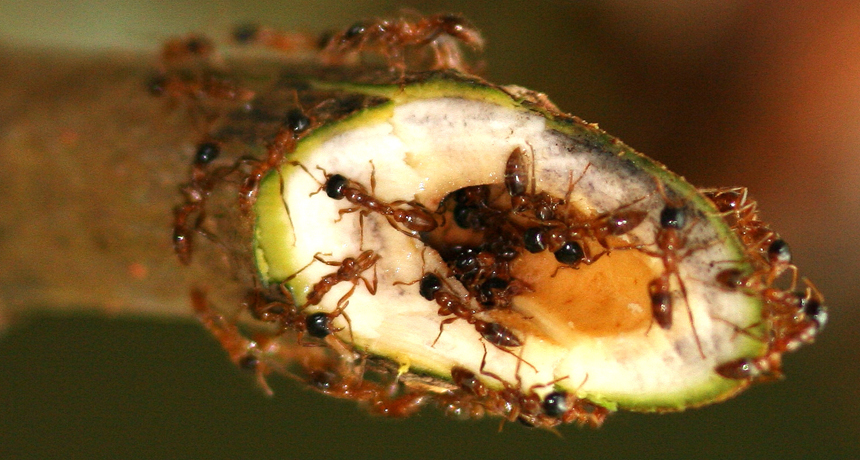
Ants protect the tangarana tree from being crowded out by other plants. In exchange, the ants live in hollow spaces in the branches.
Tiffany Weir
By Roberta Kwok
One summer day in 2001, John Styrsky was searching the rainforest in Panama for a bird’s nest. As he wandered around, he accidentally bumped into a tree called an acacia. Suddenly, he recalls, “I started feeling these really intense stinging sensations on my neck and back.”
Panicked, the biologist took off his shirt and tried to brush off whatever was causing the pain. He discovered about 15 ants from the acacia tree swarming his skin. Known as acacia ants,these insects grab their victim’s skin with mouthparts called mandibles. Then the ants pierce the skin repeatedly, injecting venom.
Each ant’s stinger is like the needle of a sewing machine. “Back and forth, back and forth, up and down, up and down, stabbing you over and over again,” he says, describing the motion. Afterward, welts the size of coat buttons emerge at each sting site, explains Styrsky, of Lynchburg College in Virginia.
The ants didn’t sting to be mean. They were just protecting their home. Many ants will guard the tree on which they live, attacking and killing other bugs that try to eat its leaves. Acacia trees in Central America, South America and Africa often house such ants. Tiny as they are, these fierce ants can scare off deer, giraffes and even elephants by stinging a browser in the face.
In return for this protection, the tree provides the ants a good home. The insects live within hollow cavities in thorns, twigs, stems or the trunk. The tree also provides food. Ants sip a sweet liquid produced by glands at the base of the tree’s leaves. The ants even dine on nodules of fat and protein on leaf tips.
By living together, the ants and plants can help each other. Their interactions are an example of symbiosis (Sim bee OH sus). Symbiosis is a relationship between two different species that live in close contact. Sometimes one organism even lives inside the other. When symbiosis benefits both organisms, it’s called mutualism.
In this story, we will explore several ways in which ants and plants share a mutualistic relationship. The benefits they swap often can take different forms. Some ants cut down interloper plants growing near their host plant. Other ants help a plant obtain more nutrients. And sometimes, a third organism will try to take advantage of these benefits too. For example, some spiders exploit the ant bodyguards to protect themselves from predators.
Lawn-mowing ants
Hardly any plants grow near tangaranas, a type of tropical tree. The surrounding ground is nearly empty. It’s “very strange,” says Jorge Vivanco. He is a plant scientist at Colorado State University in Fort Collins. “All of a sudden, you walk into a bare patch and the only things that you see are trees of this kind.”
Vivanco’s team wondered if ants somehow protected their tree — not just from munching animals, but also from other plants.
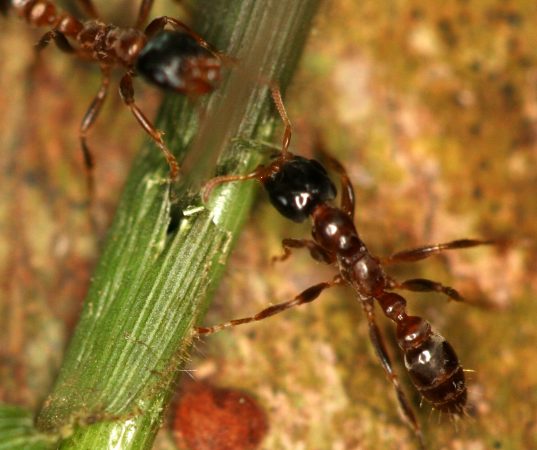
Plants compete with each other for water, light and nutrients. If other plants started growing near the tangarana tree, its own growth might suffer. And if the tangarana died, the tree’s ants would go homeless and hungry. The insects live in hollow channels in the trunk and branches. They eat sugars and fats produced by the tree; they also prey on other insects on the tree.
To test the idea the ants protected tangaranas from getting crowded out, the researchers planted seedlings around the trees. Some were grasses and ferns. Others were tangarana seedlings.
Then the researchers watched what happened. Just as they expected, the ants attacked the foreign plants. They cut off the plants’ leaves and stems with their mandibles. But they left most of the tangarana tree seedlings alone.
The team also pinned leaves from the various plants onto tangarana tree trunks. Again, the ants bit the leaves from the strange plants, but usually ignored tangarana leaves.
The experiments left the researchers wondering how the ants could tell the tangaranas apart from the other plants. One guess: Maybe they could smell chemicals produced by their host tree.
To test this idea, the researchers extracted chemicals from the host tree’s leaves. They soaked strips of paper in the chemicals. Then they pinned those strips, along with strips having no tangarana scent, to a tangarana trunk. The ants mainly cut up the paper that lacked the tangarana’s chemicals.
The results suggest that the tree relies on the ants for protection from plant competitors. In return, the ants get food and a place to live. Perhaps other plants in the forest normally grow faster than the tangarana tree. If these hardy plants sprouted nearby, they would hog all the nutrients, water and light. Concludes Vivanco: “This tree basically needs the ants to survive.”
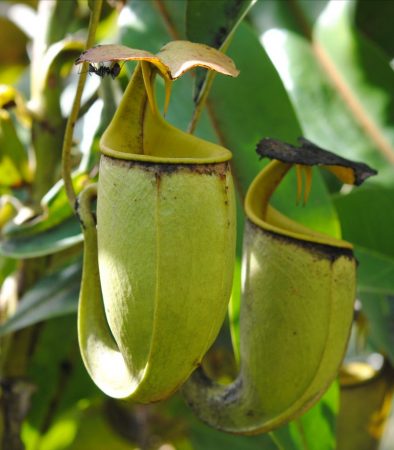
Another team has studied a rather peculiar ant plant. Found in the peat swamp forests of Borneo, a large island in Southeast Asia, this carnivorous plant allows one ant species to live on it.
This pitcher plant eats most other insects. Just as its name suggests, traps that are the shape of pitchers grow upon the plant’s leaves. Bugs that crawl on the pitcher’s slippery rim often fall into its cup. There the unlucky victims drown in fluid. The plant then slowly digests the dead bugs to “eat” them.
But one species, the diving ant, can avoid this trap. Scientists don’t know how, but these ants walk across the pitcher’s rim without slipping. And even those that do fall into the cup can swim through the fluid and climb out again. “It’s almost impossible to drown them,” observes Mathias Scharmann. He’s a biologist at the Institute of Integrative Biology in Zurich, Switzerland.
Scharmann wondered why the plant welcomed these ants, which live in its hollow stems. They eat the plant’s nectar and even dine on insects that have drowned in the pitchers. What the ants don’t seem to do is spend much time defending the plant against leaf-eating animals. “It’s not obvious what the plant is getting out of this relationship,” says Scharmann.
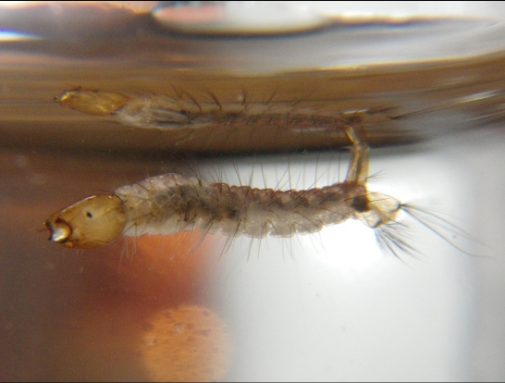
Perhaps, he thought, the ants protect the plant from these poachers.
To investigate, the researchers set up some experiments in a Borneo forest in 2011. They dropped some fly larvae into a pitcher plant. The ants attacked the larvae. They did this even though the larvae were about 20 times bigger than the ants. After stinging fly larvae, the ants dragged them from the fluid — and ate them.
When the researchers added mosquito larvae to the cup, the ants killed and ate them as well. Sometimes the ants even paused on the pitcher rim, waited for a larva to swim by, and then grabbed it.
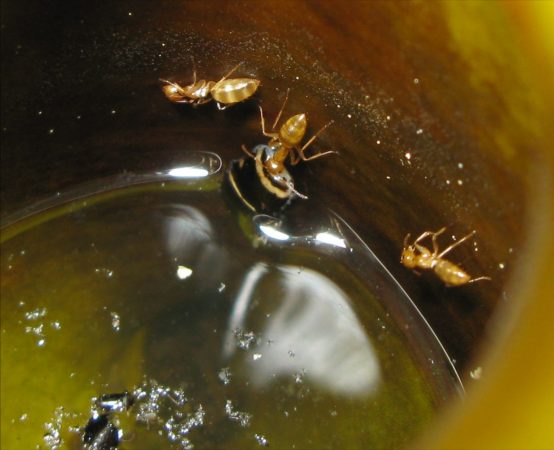
But it turns out there was. Scharmann’s team found that the ants return some nutrients to the plant as they poop into the pitcher’s cup. The ants also throw in other waste, such as bits of shed skin and entire dead ants. The nutrients contained in the trapped insects would pass first from the larvae to the ants and then, via the ant poop, back to the plant.
“Now the circle is closed,” says Scharmann. The ant does help the plant — just in a roundabout way.
Stay still, spider
Sometimes, other species take advantage of the mutualistic relationship between ants and plants. By living on the tree with the ants, these freeloaders gain added protection for themselves.
Styrsky discovered this during his trip to Panama. He found ants do not attack every species that visits their plant homes. Orb-weaver spiders have learned a trick for coexisting with acacia ants.
These spiders spend most of the day resting on the acacia tree. Yet instead of attacking the spiders, the bodyguard ants walk right past them. Sometimes they crawled right over the spiders.
Normally, when ants spot intruders, they “just go bonkers,” notes Styrsky. “But it seemed like they were just ignoring the spiders.”
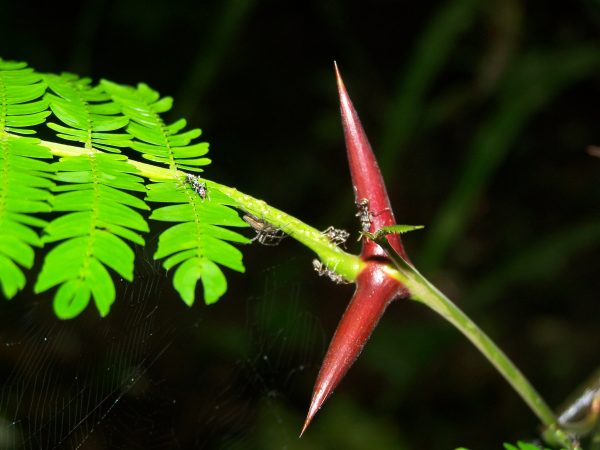
To find out, Styrsky returned to Panama in 2008 and 2009. His team collected orb-weaver spiders and spiders from another common species in the local forest. The researchers froze some of the spiders, killing them. Then they placed either the frozen spiders or live spiders onto the plant leaves — and watched what happened.
The ants often ignored the frozen spiders.
Living spiders provoked a different reaction. Agitated after being dropped on the leaf, the live spiders usually moved a bit. Sensing vibrations from this movement, the ants swarmed.
This suggested motion might be triggering the ants’ attack. And the orb weavers had devised a clever escape. They first spun a silken thread and used it to drop down from the leaf. There, dangling, the spiders waited for the ants to calm down. Later, when the spiders sensed it was safe, they clambered back onto the leaf. This time, the spiders sat motionless. And now the ants ignored them. “If you just sit still and don’t move, then the ants won’t notice you,” concludes Styrsky.
The other spiders weren’t so smart. “It’s like they panicked,” he says. Instead of hiding or staying stock still, they started running faster. This riled up the ants even more. Finally, he observes, the spiders “just got so freaked out that they would either just jump off the plant, or in a few cases, the ants were actually able to sting them to death.”
Remaining motionless may save the spiders, but this strategy requires a lot of courage. The spider must not move even while venomous ants crawl atop it. Imagine staying stock still while the Panamanian jungle ants that chomped on Styrsky swarmed all over you.
Given the danger, it still wasn’t clear why the spiders even would want to live on this plant. Styrsky thinks that the spiders benefit from the presence of the aggressive ants, just as the plant does. Lizards and birds like to eat spiders. But if those animals come near the plant, the ants will attack them. The ants may not know it, but they are scaring off the spiders’ predators as well.
The relationships that ants and plants share may seem strange, but these odd couples get a lot out of working together. Each needs the other to survive. “If one of the partners dies, then the other partner will likely die too,” says Styrsky.
ATTACK OF THE ANTS Ants hunt a fly larva in a pitcher plant’s fluid-filled cup.
Credit: Scharmann et al/ PLOS ONE 2013
Power Words
acacia A tree or shrub with white or yellow flowers that grows in warm climates. It often has thorns.
Borneo A large island in Southeast Asia.
carnivorous plant A plant that trap animals, usually insects, as food.
gland A cell, a group of cells or an organ that produces and discharges a substance (or “secretion”) for use elsewhere in the body or in a body cavity, or for elimination from the body. Plants also make glands that secrete a substance.
larva (plural: larvae) An immature life stage of an insect, which often has a distinctly different form as an adult.
mandibles Mouthparts on an insect that are used for biting.
mutualism A type of symbiosis in which both organisms benefit from the relationship.
nodule A small roundish bump or growth.
pitcher plant A carnivorous plant that traps bugs in traps filled with fluid and shaped like pitchers.
poach (in ecology) To illegally hunt and take a wild animal. People who do this are referred to as poachers.
predator (adjective: predatory) A creature that preys on other animals for most or all of its food.
species A group of similar organisms capable of producing offspring that can survive and reproduce.
symbiosis A relationship between two species that live in close contact.
tangarana A tree that lives in the tropics and is protected by ants.








